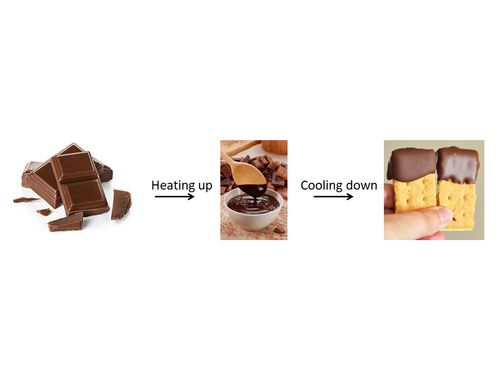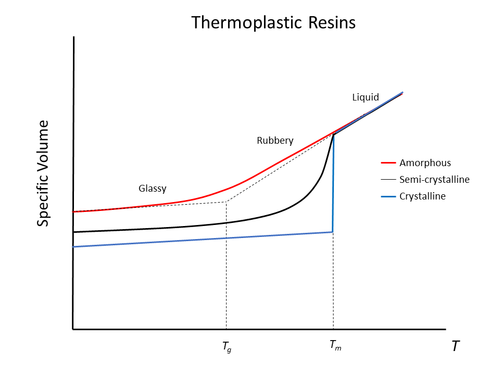Thermoplastic polymers - A161
| Thermoplastic polymers | |
|---|---|
| Foundational knowledge article | |

| |
| Document Type | Article |
| Document Identifier | 161 |
| Themes | |
| Relevant Class |
Material |
| Tags | |
| Prerequisites | |
Introduction[edit | edit source]
Thermoplastics or thermoplastic polymers are one of the two groups of polymers (the other being thermosets). Upon heating, thermoplastics soften and melt where they flow in a manner of a viscous liquid, and then solidify again upon cooling. This process is repeatable upon repeated heating and cooling, making them potentially recyclable.
Scope[edit | edit source]
This page provides a brief overview to the family of polymers classified as thermoplastics or thermoplastic polymers.
Significance[edit | edit source]
Thermoplastics are a polymer matrix material for fibre reinforced composites. Common examples include Polyethylene (PE), Polyproplyene (PP), Polyether ether ketone (PEEK), and Polyether imide (PEI). Material characteristics such as higher ductility and facture toughness compared to thermosets, make thermoplastics a popular matrix choice for certain applications.
Prerequisites[edit | edit source]
Recommended documents to review before, or in parallel with this document:
Overview[edit | edit source]
Thermoplastics or thermoplastic polymers are one of the two groups of polymers (the other being thermosets). Upon heating, thermoplastics soften and melt where they flow in a manner of a viscous liquid, and then solidify again upon cooling. This process is repeatable upon repeated heating and cooling, making them potentially recyclable.
As a composite matrix material, thermoplastics have their advantages and disadvantages compared to thermoset resins [1].
Advantages of thermoplastics:
- Indefinite shelf-life
- Short processing time
- High ductility and facture toughness
Disadvantages of thermoplastics:
- Elevated temperature for processing (required to melt the thermoplastic)
- Relatively high flow viscosity (difficult to flow) due to long polymer chains
Material Forms[edit | edit source]
- Pellets
- B-staged with reinforcement fibres (prepreg, commingled fibres, etc.)
Please see the systems catalogue for more information regarding thermoset resin material forms (Thermoplastic Polymers - Systems Catalogue page).
Transformation During Processing[edit | edit source]
When heated above the glass transition temperature (Tg), thermoplastics become progressively softer. Above melting temperature (Tm) they liquefy into a viscous melt. If cooled down, the material solidifies again.
As thermoplastic polymers are cooled, they solidify. During this process, the polymer chains have the ability re-organize into organized and folded crystalline structures. Some polymer chains will organize themselves into ordered crystalline structures while other regions of the polymer will solidify in random molecular configurations, referred to amorphous regions.
Click here to learn more about melt and crystallization of thermoplastic polymers.
For thermoplastics, depending on the proportion of amorphous and crystalline regions, above Tg, polymer chain mobility increases and material becomes softer. As the heating continued, above melting point, material goes through a phase transition and becomes liquid. As a result, volume changes abruptly.
Even in the molten state, thermoplastic polymers remain a highly viscous melt consisting of long polymer chains of high molecular weight. To push the long polymer chains into motion, thermoplastics require a high applied force to shape. Typically, this required force is higher than the forming force required for low viscosity thermoset polymers – which consist of short molecular length monomers prior to polymerization (curing process).
The ability to heat thermoplastics and liquefy them, mean that thermoplastics are recyclable polymer materials. They can be melted, and reformed for re-use. Common recycled household plastics such as polyethylene (PE) and polyethylene terephthalate (PET) are all thermoplastics.
Example Thermoplastic Materials[edit | edit source]
Examples of popular thermoplastics used as polymers matrices include:
- Polyethylene (PE)
- Polyproplyene (PP)
- Polyether ether ketone (PEEK)
- Polyether imide (PEI)
- Polytetrafluoroethylene (PTFE) (Teflon)
For more information on popular thermoplastic matrix materials, see the catalogue volume thermoplastic matrix page.
Related pages
References
- ↑ [Ref] Hoa, S V (2018). Principles of the Manufacturing of Composite Materials. DEStech Publications, Incorporated. ISBN 9781605954219.CS1 maint: uses authors parameter (link) CS1 maint: date and year (link)
| About | Help |
Welcome
Welcome to the CKN Knowledge in Practice Centre (KPC). The KPC is a resource for learning and applying scientific knowledge to the practice of composites manufacturing. As you navigate around the KPC, refer back to the information on this right-hand pane as a resource for understanding the intricacies of composites processing and why the KPC is laid out in the way that it is. The following video explains the KPC approach:
Understanding Composites Processing
The Knowledge in Practice Centre (KPC) is centered around a structured method of thinking about composite material manufacturing. From the top down, the heirarchy consists of:
- The factory
- Factory cells and/or the factory layout
- Process steps (embodied in the factory process flow) consisting of:
The way that the material, shape, tooling & consumables and equipment (abbreviated as MSTE) interact with each other during a process step is critical to the outcome of the manufacturing step, and ultimately critical to the quality of the finished part. The interactions between MSTE during a process step can be numerous and complex, but the Knowledge in Practice Centre aims to make you aware of these interactions, understand how one parameter affects another, and understand how to analyze the problem using a systems based approach. Using this approach, the factory can then be developed with a complete understanding and control of all interactions.
Interrelationship of Function, Shape, Material & Process
Design for manufacturing is critical to ensuring the producibility of a part. Trouble arises when it is considered too late or not at all in the design process. Conversely, process design (controlling the interactions between shape, material, tooling & consumables and equipment to achieve a desired outcome) must always consider the shape and material of the part. Ashby has developed and popularized the approach linking design (function) to the choice of material and shape, which influence the process selected and vice versa, as shown below:
Within the Knowledge in Practice Centre the same methodology is applied but the process is more fully defined by also explicitly calling out the equipment and tooling & consumables. Note that in common usage, a process which consists of many steps can be arbitrarily defined by just one step, e.g. "spray-up". Though convenient, this can be misleading.
Workflows
The KPC's Practice and Case Study volumes consist of three types of workflows:
- Development - Analyzing the interactions between MSTE in the process steps to make decisions on processing parameters and understanding how the process steps and factory cells fit within the factory.
- Troubleshooting - Guiding you to possible causes of processing issues affecting either cost, rate or quality and directing you to the most appropriate development workflow to improve the process
- Optimization - An expansion on the development workflows where a larger number of options are considered to achieve the best mixture of cost, rate & quality for your application.
To use this website, you must agree to our Terms and Conditions and Privacy Policy.
By clicking "I Accept" below, you confirm that you have read, understood, and accepted our Terms and Conditions and Privacy Policy.







